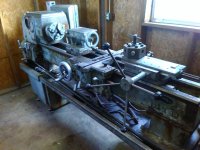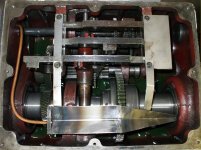Simple question. Given the condition and inability to test things, would you buy this?
I will, of course, spend some time going over the machine as well as I can, to verify all the parts are there, but I recognize that I might miss something. Hopefully it would not be something I couldn't make myself. I like the size of the machine, and I appreciate how beefy it is given it's size. I think it would make an awesome machine, and put my little Logan in the classifieds (after getting it up and running)

I will, of course, spend some time going over the machine as well as I can, to verify all the parts are there, but I recognize that I might miss something. Hopefully it would not be something I couldn't make myself. I like the size of the machine, and I appreciate how beefy it is given it's size. I think it would make an awesome machine, and put my little Logan in the classifieds (after getting it up and running)

Cincinnati Tray Top 12.5" x 48" Metal-Cutting Lathe - tools - by...
Cincinnati Tray Top 12.5" x 48" Metal-Cutting Lathe This metal-cutting lathe is a beast, and was made in the late 1950's, I believe. There was some backlash in the cross-slide that I couldn't adjust...
dallas.craigslist.org



